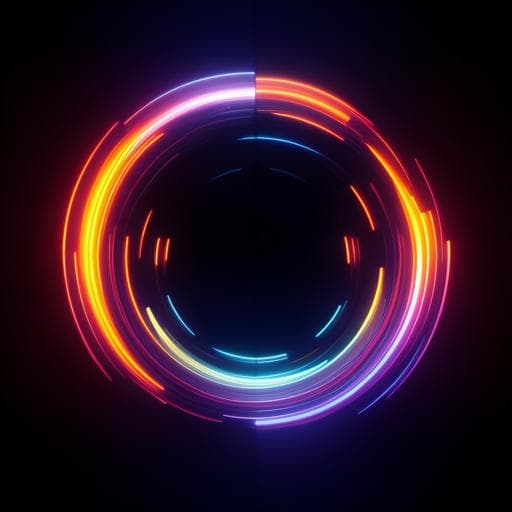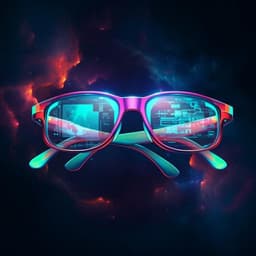
Engineering and Technology
Full-colour 3D holographic augmented-reality displays with metasurface waveguides
M. Gopakumar, G. Lee, et al.
This groundbreaking research by Manu Gopakumar, Gun-Yeal Lee, Suyeon Choi, Brian Chao, Yifan Peng, Jonghyun Kim, and Gordon Wetzstein unveils a revolutionary holographic augmented reality system that delivers stunning full-colour 3D AR content in a compact design. By integrating advanced optics and AI-driven algorithms, this work promises to redefine immersive experiences in AR technology.
~3 min • Beginner • English
Introduction
The study addresses key limitations of current augmented-reality (AR) glasses: bulky projection optics that increase device thickness and limited capability to portray correct 3D depth cues, which leads to vergence–accommodation conflict and reduced realism. The research question is whether a co-designed metasurface waveguide and holographic light engine, paired with learned wave-propagation models, can deliver compact, optical-see-through AR with high-quality full-colour 3D imagery. By replacing conventional amplitude SLM projector optics with a lensless, phase-only SLM located close to an in-coupler and by engineering the waveguide and couplers for dispersion correction and uniformity, the authors aim to realize eyeglass-like form factors that provide true 3D cues and high see-through efficiency.
Literature Review
Waveguide image combiners are widely considered the most promising approach for compact near-eye AR, but conventional systems require projection optics with thickness proportional to lens focal length and typically display 2D content at a fixed distance, causing vergence–accommodation conflict. Prior attempts to adapt digital holography to AR configurations showed promise but fell short in achieving compact form factors and high 3D image quality. Metasurfaces have demonstrated advantages over conventional diffractive and refractive optics, including higher diffraction efficiency, spectral selectivity, Q-factors, and transmittance, and have been explored for AR/VR elements. Inverse design in nanophotonics enables tailored metasurface behavior for complex constraints. Recent camera-in-the-loop and neural holography approaches improved hologram quality and model fidelity for benchtop holographic VR/AR but had not been applied to compact OST waveguide systems. Related waveguide holography for non-see-through VR has been limited by image quality. This work integrates these threads: inverse-designed metasurface couplers, dispersion-compensating waveguide geometry, and learned wave-propagation models for OST, full-colour 3D AR.
Methodology
Hardware and optical co-design: The system uses a high-index glass waveguide with all-glass, inverse-designed metasurface grating couplers for in- and out-coupling. A phase-only SLM is placed very close to the in-coupler, eliminating bulky collimation optics. High-index glass (n > 1.8, k ≈ 0) enables total internal reflection across RGB and sufficient light–matter interaction for efficient, broadband, high-angle diffraction, improving both see-through and diffraction efficiencies compared to typical glass.
Dispersion-compensating geometry: Chromatic dispersion is corrected at the system level by matching the momentum vectors of in- and out-couplers (equal magnitude, opposite direction) and by engineering the waveguide thickness and coupler spacing so RGB pupil replicas laterally align at the out-coupler. With d_wg = 5 mm and grating period Λ = 384 nm, in-coupled RGB wavefronts undergo 1, 3, and 5 internal reflections, respectively, then meet at the out-coupler. This LCM-based geometric design yields full-colour operation with high uniformity.
Metasurface inverse design: Using rigorous-coupled-wave analysis (RCWA) and gradient-based optimization (Adam), the authors design single-layer, TE-polarized metasurface gratings maximizing first-order diffraction efficiency for RGB (638/521/445 nm) while minimizing angular variance in efficiency over ±5° incidence. The design assumes 1D symmetry (x-axis) and includes Gaussian blur to model fabrication tolerances. The optimization converges to an asymmetric double-lined grating with period 384 nm and height 220 nm that steers high-angle diffraction for RGB with improved angular uniformity. Transfer functions indicate substantially higher efficiency and uniformity versus conventional single-line gratings, especially for green and blue.
Fabrication: Metasurfaces are directly patterned into lead-containing high-index SF6 glass (SCHOTT) via electron-beam lithography, using a reverse-patterning approach with positive e-beam resist (PMMA) and multiple dry etching steps. This avoids lift-off masks and physical etching steps that can introduce contamination or surface irregularities, maintaining a clean, protected glass surface. The process is compatible with photolithography or nanoimprint for scaling.
Physical-optical waveguide model: The in-coupled wavefront is modeled as a phase-modulated, converging illumination multiplied by the in-coupler aperture. Propagation through the waveguide uses a frequency-domain transfer function H_WG that accounts for first-order diffraction, reflections, and translation from in- to out-coupler, followed by out-coupler aperture and free-space propagation to target depths. Equations specify u_ic(e), u_oc(e), and f_WG(e, d_target) via Fourier-based propagation and free-space operator f_free.
Learned components (camera-in-the-loop): To bridge modeling–hardware mismatch (aberrations, fabrication errors, SLM/electro-optic effects, source), the authors augment the physical model with learnable elements: complex-valued in-/out-coupler apertures/efficiencies, spatially varying diffraction efficiencies, and CNNs at the in-coupler and target planes (CNN_ic, CNN_target). These are trained using camera feedback (camera-in-the-loop) on the fabricated prototype, yielding a fully differentiable propagation model suitable for gradient-descent CGH.
Experimental prototype and calibration: The prototype uses a HOLOEYE LETO-3 phase-only SLM (1080×1920, 6.4 μm pitch) and a FISBA READYBeam fiber-coupled RGB laser module (638/521/445 nm). Illumination and SLM are slightly tilted to prevent pre-coupling stray light from obscuring content. Data are captured with a FLIR Grasshopper3 12.3 MP color camera through a Canon EF 35 mm lens, with focus controlled via Arduino. Partial coherence is used by time-multiplexing a few coherent modes to reduce speckle and improve depth rendition. Holograms are synthesized with gradient-descent CGH incorporating the learned propagation model.
Key Findings
- The inverse-designed all-glass metasurface couplers achieve high visible-range see-through transmittance, measured at approximately 78.4% across the visible spectrum.
- Angular uniformity of the metasurface transfer function is high: 61.7% (red), 91.2% (green), and 98.3% (blue), substantially exceeding conventional grating uniformities (58.9%, 47.7%, 88.8%, respectively).
- The metasurfaces deliver higher diffraction efficiency and more uniform angular response than conventional single-line gratings, particularly in green and blue; red remains more challenging due to its large diffraction angle.
- The learned physical waveguide model (physics + camera-calibrated CNNs) improves experimental hologram quality, outperforming free-space and purely physical models by 3–5 dB PSNR across tested 2D targets.
- The system demonstrates high-quality full-colour 3D holography with correct in-focus and out-of-focus rendering, mitigating vergence–accommodation conflict, and shows compelling optical-see-through overlays of digital content onto physical scenes.
- The demonstrated field of view is 11.7°, comparable to many commercial AR systems, in a compact waveguide form factor.
- The approach eliminates bulky projection optics by placing a phase-only SLM near the in-coupler, enabling a compact, eyeglass-like device geometry.
Discussion
By co-designing inverse-designed metasurface couplers, a dispersion-compensated waveguide geometry, and camera-calibrated learned propagation models, the system directly addresses the two central AR challenges: bulk from projector optics and lack of correct 3D depth cues. The compact, lensless light engine and high-index, single-layer metasurface couplers enable a thin waveguide with high see-through efficiency and uniformity, while the learned model compensates for real-world optical deviations to produce high-fidelity holograms. Experimental results confirm substantial image quality gains (PSNR) and accurate depth-of-field rendering in full colour for optical-see-through operation, indicating reduced vergence–accommodation conflict and improved realism. Although current field of view (11.7°) and computational speed limit immediate deployment, the demonstrated platform provides a feasible path toward visually compelling, compact AR glasses leveraging metasurface nanophotonics and AI-driven holography.
Conclusion
The work introduces a compact, full-colour 3D optical-see-through AR display based on a lensless, phase-only holographic light engine integrated with an inverse-designed metasurface waveguide. Key contributions include: (1) a dispersion-compensating waveguide geometry enabling RGB operation with high uniformity; (2) all-glass, single-layer metasurface couplers with high see-through transmittance and improved angular response; (3) a hybrid physical–learned wave-propagation model calibrated with camera feedback that significantly enhances hologram quality; and (4) a functioning prototype demonstrating high-quality full-colour 3D overlays. Future directions include increasing field of view (e.g., higher-index materials or metasurface eyepieces), reducing waveguide thickness with smaller-pitch SLMs, expanding étendue, integrating an illumination waveguide for a more compact light path, and accelerating CGH to real time via machine learning.
Limitations
- Field of view is currently limited to 11.7°; broader FOV will require higher-index materials or additional metasurface optics.
- Waveguide thickness is tied to SLM size; current SLM pixel pitch (6.4 μm) constrains further thinning. Emerging ~1 μm-pitch SLMs could enable ultrathin designs.
- System étendue is limited by the SLM space-bandwidth product; étendue expansion techniques have not yet been demonstrated for full-colour 3D waveguide holography.
- Computational cost: runtime CGH synthesis currently takes several minutes per phase pattern; real-time operation will require further algorithmic and ML acceleration.
- Red channel diffraction efficiency is harder to optimize due to larger required diffraction angles, leaving room for further metasurface design improvements.
Related Publications
Explore these studies to deepen your understanding of the subject.







